One Year Anniversary!

|
• Armonia Bay Hotel • Kokkari Beach Hotel • Emily Hotel Samos • Samos Hotel |
In Focus, Bangkok Images has now been on-line a full year!
When I first decided to commit to this column my original commitment was six months. My plan was to reevaluate after six months and see if my main goals were being meant. My goals included building an increasing readership, to solicit reader
participation in the form of questions and image submissions, and to receive constant feedback from the readers on the quality of the column and how it can improve. Most of these goals have been met and surpassed, a few I still need to work on. It
was an easy enough decision to continue past the six months for another six months. Now I’m looking forward to committing for another year.
This weekly column is a combined effort. We have a team and I’d like to introduce you to the team. First, there is me, BkkSteve. And finally there is you. Each reader is part of the team responsible for creating a quality weekly column. Your questions,
feedback, and contributions are invaluable and I couldn’t do it without you.
On that note I’d like to say THANK YOU VERY MUCH to Stick who not only mocks these up, often on short notice, but as a photographer he asks questions and has contributed to the readers
submissions and even some learning topics. I can’t count the number of times he’s went to the trouble of mocking things up for me and then I’ll send in changes and ask him to do it over. I’m a visual person and until
I see the final product I don’t know if things are as I want them.
Then we have Tom Tweedle from Texas. Thank you Tom! Great readers submissions and outings on China, nightshooting, and panoramics, even better outing and learning topics. KVW is another big contributor. Readers subs, questions, and two great outings from
his trip to Africa! Dr. Palozza who runs his own workshops has contributed an outing section on Antarctica. Tom Parsons with his great Philippines Special and frequent questions. Akulka, we can’t forget about Akulka! Wonderful specials
from the DPRK and more recently from the Philippines. Lots of subs and questions as well. Thank you! And then the hundreds of readers who sent in questions and images, THANK YOU! I’m sure I forgot someone, maybe several someone’s. I apologize in advance and I want to thank you too.
Seriously. I couldn’t do this without the above individuals. I wouldn’t want to do this without them. Without the people who ask questions, submit images, and create great topics on their own.. without them we wouldn’t have community.
Community is what I think makes this weekly column special.
I asked a few people what I should do for an anniversary issue. I was told to just show a selection of my favorite all time images and talk about them a bit. The trouble is I have many favorite images. Only a couple really stick out for me personally
so I will talk about one certain image. I’m also going to talk about something I very much enjoy doing. I’m going to describe in detail a recent workshop. I was able to work one on one with a sharp individual and we had a great time
and made some great captures. I’m going to share the trip and the captures with you.
But first, the image.

Meet Charlie. Charlie was a rescue parrot. He’s a Blue Front Amazon. He was my dad’s parrot. When my dad passed from cancer Charlie was doing his best to pass right along with him. A vet visit revealed he was only 1/5th -1/3rd his normal
weight, his feathers had mostly fallen out, and the vet told us he’d die within days. My dad smoked heavily and Charlie was trapped in a room with no windows open or other ventilation for his entire 20 years.
I didn’t like parrots. I was a dedicated dog person. My wife saw a pet that needed help and soon she was hand feeding him, and holding him almost all the time. Charlie went from lifeless with no feathers, drab color, very light weight, and no desire
to move or talk.. to nine months later to what you see here. All his feathers grew back under a proper diet and with brilliant colors. His eyes are bright and he loves to play games.
According to the vet Charlie was one of the best specimens of a Blue Fronted Amazon he’d ever seen. Charlie who had never flown before in his life, wings always clipped, was put through a program at home to exercise his atrophied muscles and to
learn to fly. Less than 2 years later Charlie was flying across the room with comfort and was very much enjoying his new life. I even bought him a little grey parrot for a friend, and Charlie hated this new parrot so I was stuck taking care the
baby. Sigh..
One day I decided to photograph him flying. This was really a technical endeavor, so I worked out the details. I’d already trained Charlie to fly from perch to perch for a peanut butter cracker, the rest were just light traps, timing, and selecting
the right equipment. These captures were all done in the studio.
The finished image looks like this.

The shutter speed and aperture gave me the exact image I was after. Perfectly focused eye, head, and frontal body, with motion blurred wing ends. Muscles rippling, feet tucked, Charlie was serious about earning that peanut butter cracker! This was a very
fun session for all involved including Charlie. He loved performing.
This image was shot with a 4mp Nikon DSLR, AF-S 28-70 lens, and a great deal of patience. This kind of detail with a 4mp DSLR? Do you really need to upgrade your current 8-10-12mp DSLR? When I think back to the difficulty in capturing this image I’m
still surprised at the number of well focused captures I made that day. Only 2-3 of them were “critically” sharp and this is one of them. I also wonder how much if any benefit I would realize with a new 21mp body? Obviously I would
end up with more pixels and could make larger prints, but at 11×14 this image prints with all the detail you see in the close crop above. I think at 11×14 I wouldn’t see any benefit, but at 20×30 there would be great benefit.
Unfortunately Charlie never made it to Bangkok. Both him and the new grey parrot were subject to mountains of paperwork through the CITES, Avian flu requirements, and the USA and Thailand governmental requirements. It took me over 3 years to make arrangements.
Charlie died one night while waiting. Fortunately my wife was there at the time so he didn’t die alone. A necropsy revealed multiple large cancerous tumors throughout his body. The doctor couldn’t believe he didn’t exhibit pain or
discomfort for a period before his passing. Charlie was too busy enjoying his second lease on life to notice. The 20+ years in an unventilated room with a heavy smoker resulted in his own cancer. These birds routinely live to be 80-100 years old.
Charlie died at 27 a young male parrot. Rest in Peace.
THE WORKSHOP EXPERIENCE
I’m going to indulge. In past columns I’ve made brief passing references to workshops, but have never really taken the reader from start to finish through a workshop. I’ve come to learn that many people don’t know what to expect
from a workshop or how they’ll benefit from one to several days of topic specific instruction.
Last month one particular workshop stood out as not only pleasant, but somewhat typical. I had a great time and felt I was able to benefit the student to a significant extent. I’m going to relate this workshop below.
What To Expect From a Workshop?
This depends on the individual. In my workshops there is no set curriculum. Everyone has a unique level of experience and individual goals. My goal is to provide a ‘custom’ workshop experience. Usually we start by talking
on the phone or via email and I ask very specific questions to give me a baseline.
I ask what equipment you have, experience levels (I’ll often ask someone to email me a few of their best images to use as a visual reference), and what specific goals you have in mind. Some want to bone up on their skills prior to a major trip
or vacation, others want to capture portraits of their loved ones, and we even get some professional photographers who want to learn specific techniques such as off-camera flash use, sports capture with long telephotos, and advanced processing
techniques.
Once I get a feel for your needs I’ll ask what venues you prefer. I’ll tell you which venues best fit your goals and allow for maximum camera/computer time. Often I’ll suggest you check out certain galleries to see if the venue is
of interest.
At this point we’ll talk scheduling and get you booked for your most convenient days if possible.
This Workshop Student
He emailed me on rather short notice with a very brief text asking what venues I had available and stated he was tired of temples and wats. This suited me fine, but it was very general and I sent back a general reply with some venue suggestions and asked
many questions.
I didn’t hear back until a few days later and then it was a phone call. He asked if we could do the workshop the next day. As luck would have it I had the next day free, so while on the phone I asked a lot of questions to ascertain his experience
level, needs, and goals. That night I loaded up my bag with lenses I thought he might find worth trying out (at this particular venue) and arranged with my assistant to be available the next morning.
We were going to the Samut Songkram Boat Yards! This is one of my favorite venues. I had the SUV cleaned and gassed and loaded the gear.
How The Day Starts
It’s 0815 and the phone rings. It’s Luke (the student) and he hands the phone to the taxi driver so I can give directions to our starting point. I could have also emailed a detailed map in English and Thai. Most clients end up staying in
the downtown area which can take away hours of the day driving in/out of the area. I’ve learned the right times for a taxi to run someone out of the area (while the rush hour traffic is jamming things up trying to get into the area) and
to the starting point in about 20 minutes for about baht 120. This really saves us a lot of time.
I’m outside waiting at the starting point in the SUV with the flashers flashing. The taxi pulls up and Luke gets out. We quickly introduce ourselves, he gets introduced to my assistant, and we jump in the SUV and are on our way. On the way out
of the soi we stop at the 7-11 and my assistant goes in to get whatever drinks and snacks everyone prefers and fills up the ice chest. It’s critical to stay hydrated and comfortable. We also pack along clean white hand towels to wipe sweat,
clean hands, and equipment.
We’re on our way!
The Drive to Samut Songkram Boat Yards
Since we leave in the morning my habit is to drive through the Mcdonald’s drive thru window on the corner. This way we can eat, drink coffee, and chat during the drive. Unfortunately they were remodeling McDonald’s this particular morning
so with bellies growling we jumped on the Expressway and headed out of town.
During the drive we get to know each other better and I ask lots of questions designed to better place skills and goals. By the time we arrive on-site I want the student to be comfortable with me, able to ask questions easily, and to have a good idea
of what we’ll do for the day. We discuss gear, experiences, and I ask a lot more questions.
Before we know it the two hour drive is behind us and we’re pulling in the boatyards. My assistant heads off to explain our presence and ensure we don’t offend or inconvenience anyone.
Camera Time, Boat Yards
By now we’ve talked enough to know Luke would really benefit from trying out an ultra-wide zoom. This is the perfect lens for this location. Almost always I’ve been to these venues at least several times before and I’m very familiar
with what lenses work best, which shooting locations offer certain advantages, and this allows the student to get more from his/her time, and allows me to concentrate on more important things.
At the back of the SUV we choose our gear, mount lenses, and discuss details such as exposure and autofocus modes, ISO settings, and make sure we’re saving to RAW files to be used later during the computer processing session.
All the images in this section were taken by Luke and processed at a later time by myself. He generously allowed me to use them for whatever I wanted to use them for, and this helped me decide to do this “The Workshop Experience” topic. Thank you Luke!
Almost immediately we see a newly prepared propeller laying on the ground. The possibilities with a ultra-wide angle beckon, and I do my best to help Luke visualize what the lens will do. Unfortunately this is very hard to visualize if you’ve never
experienced an ultra-wide before, which is why we’re here. I can talk him through it, show him where to stand, what angles work well, and suggest settings. We can also discuss any of the cameras systems or settings necessary and while we
do discuss a few, Luke has a good handle on this area which allows us to up the game a bit.
Luke sets up to shoot and I urge him to get closer. “Closer Luke, use the force..” He steps up a bit closer and takes the shot.
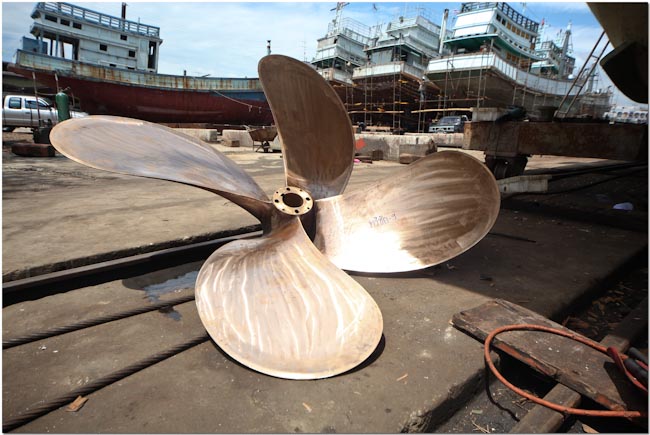
I ask to hold his camera and taking a look at the image(s) on the LCD and settings I can instantly see where to offer advice. His aperture was set at F9 which was fine, but the lens was set at 24mm and not the wider end at 12mm. You see, for Luke 24mm
was very wide. But I wanted him to see what makes an ultra-wide a superb tool for such shots so I urged him closer and suggested he set the lens at 12mm. This took him a while to move up enough, to Luke it seemed unnaturally close and awkward.
Then I suggested he kneel down for the best angle. By now he was thinking I was crazy.. but he completed the capture.
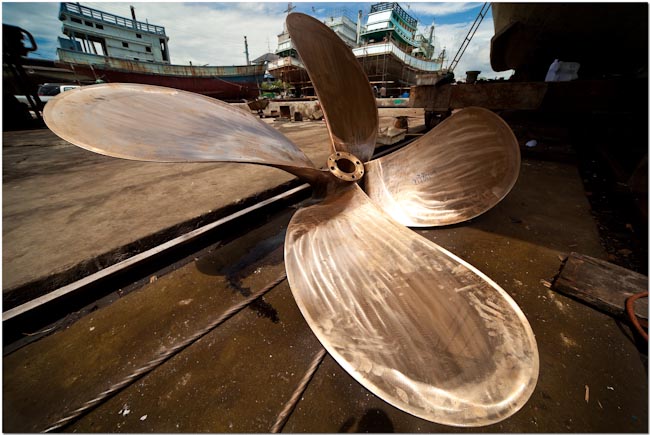
I watched his face as he looked at the LCD to see the resulting image and a big smile crossed his face. This was more like it! Notice how the blade closest to the camera looks very exaggerated and the boats in the background now look a lot smaller? An
ultra-wide is all about a different perspective and 12mm being the widest rectangular lens available for any DSLR period.. it provides perspective in spades. Now, Luke had an idea of how this lens might be best used.
A short distance away we see a ship being hauled out of the water and on the ‘tracks’. The pulley’s and cables make for an interesting foreground, the ship a great mid-ground, and the great sky and clouds a rare (for Thailand) background.
I show him where to shoot from and what settings, and he produced this beautiful shot straight away.
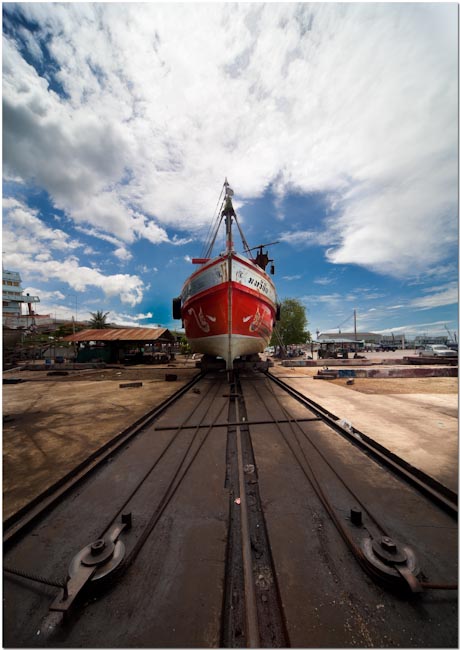
He plays around with this scene for a while, different exposures, slightly different angles, and examining the image on the LCD after each shot. He’s getting used to the lens and trying different things.
I suggest he try to get even closer to the foreground (pulley’s) so they really stand out, and to put the camera into landscape orientation for greater effect. He does and look how great this shot is! On a full size print you can almost smell the
grease on the pulley and feel the rust on the cable.
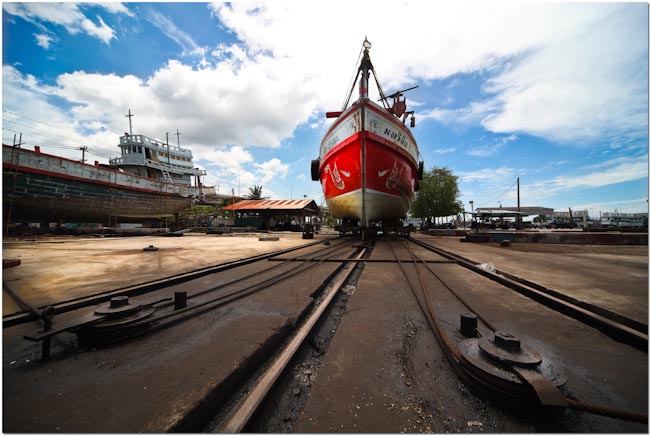
We’re having fun now, he’s got some great captures, a feel for the lens, so we move on to the next subject. It’s a rail dolly. I ask him to think about the scene and make the best capture. He spends some time taking different angles,
different focal lengths and settings, but doesn’t look happy with the results.
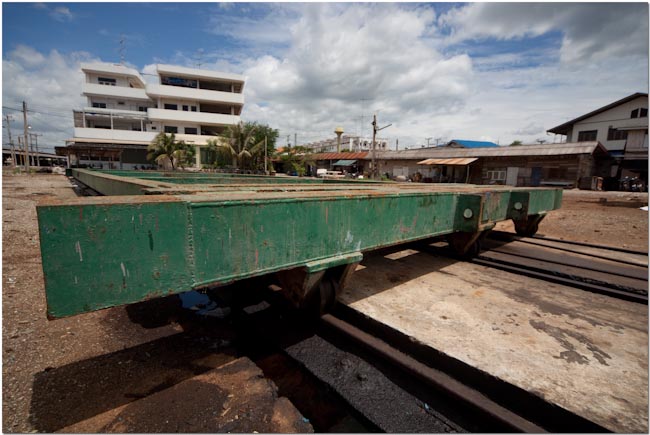
Looking at the image we can see that at 17mm the perspective was okay, but the capture with the drab buildings in the background weren’t very interesting. “Re-programming” your mind to think “ultra-wide” is very difficult
and takes lots of experience. What I try to do is shorten the time frame by demonstrating the use of the lens. Much of what took me years to learn on my own (concerning ultra-wide use) I can pass on to an astute student in a day or two.
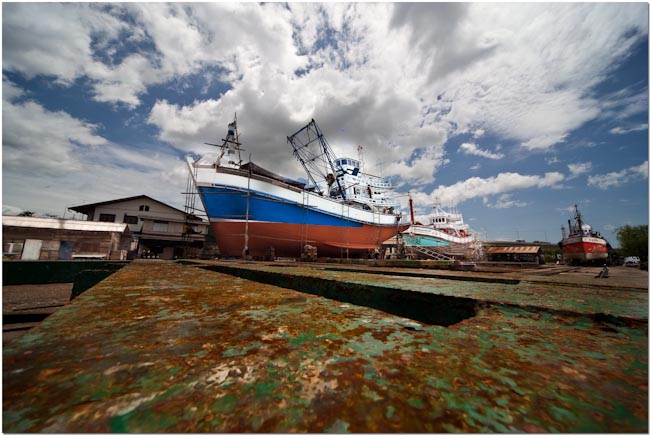
I mention that perhaps an interesting capture using the track dolly might be possible if we use only part of it as a foreground, use the interesting rust and texture to capture the eye, and then turn around all 360 degrees and look for the most interesting
mid-ground with the best background. I show him the scene, suggest he shoot at an upward angle, and the capture is made. Luke looks at his LCD and the big smile returns!
We continue on through the boat yard and he captures the workers doing various tasks. Using an ultra-wide to make great people shots is very difficult, this is probably best learned after a great deal more practice. Still, he’s exhibiting a good
eye so I continue to watch without saying much.
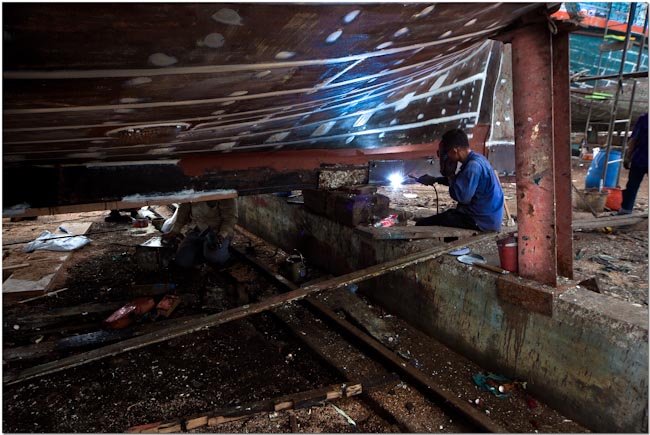
We see a worker welding under a ship and I nudge him over. Luke makes the perfect exposure settings and takes the capture. Actually, we’ve already discussed manual exposure control and the values of bracketing, so he takes about 5-7 exposures and
one of them is spot on. This is how the pros do it. What a great wide-angle person shot! I really like this one.
He moves on and takes a lot of captures of some men sanding and reconditioning a big rudder. Looking at the sequence of shots I see this image and I don’t remember him taking it.
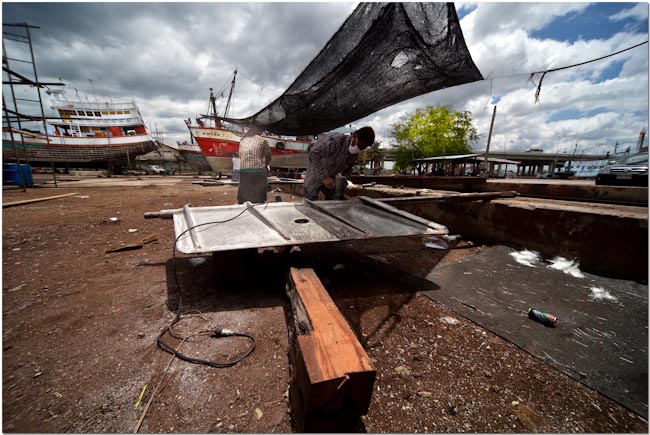
But I love it! Great directional light, a foreground, mid-ground, and background. Interesting colors, and plenty of points of interest.
We continue on through the boat yard and Luke is really getting the feel for using a ultra-wide angle. Another hour of shooting, tons of sweat (very hot day) and we head back to the SUV. At the SUV we turn on the AC to cool off and my assistant hands
us packages with a ice cold wet towel inside. We break them open and they feel really good. She hands us a cool drink as well. A great assistant is worth their weight in gold.
As we sit there we discuss what we did, go over any nagging questions, and if the light was better we might have looked at the LCD right there. The light was too bright so we saved the LCD viewing for later.
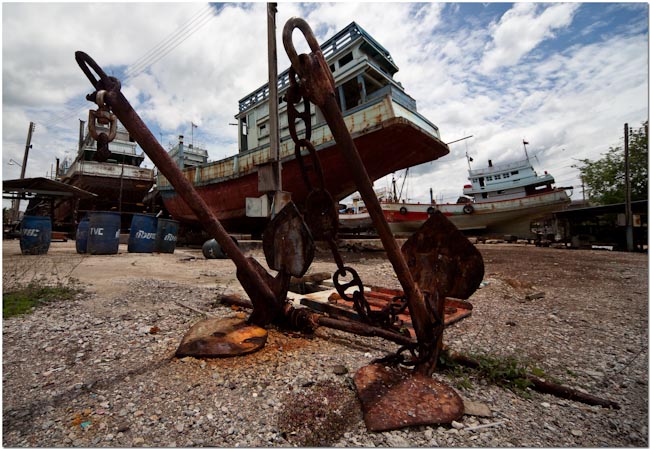
While sitting there I talked about the value of always looking around you for an ideal scene. How you need to train your mind to look for such photographic opportunities and that they’re all around you. All the while I’m looking at a set
of dual anchors. Luke catches on and jumps out of the SUV for one last capture before heading out.
Lunch Time
By now we were hungry. Mcdonald’s let us down in the morning and now we were too far away, so we settled on MK and drove the 8km’s back to the town center. While eating lunch we reviewed the images on the LCD, talked about them, answered
any questions, and enjoyed good food. During lunch we also discussed where to go next. Our primary location was exhausted and we had some time to explore other nearby venues.
We settled on the Chotika River Front Hotel. This is a great place to stay the night, especially for a quiet romantic getaway. More importantly
it’s also a great place for photography.
Chotika River Front Hotel
The Chotika River Front Hotel is built around an inactive lumber mill. The owners of the mill decided to build a hotel during the time the lumber business was in a slump and they did a nice job. The hotel flanks both sides of the mill.
Walking along the wood decks that line the rooms and shops we talked about how an ultra-wide angle lens can make an ordinary scene look very special. I had my eye on a bright yellow canoe sitting on the deck ahead of us and soon Luke saw it too. We had
to discuss getting very close to the subject again. This is common, it’s easy to forget how close you can get with such a lens and how much difference just 10-15cm’s can make.
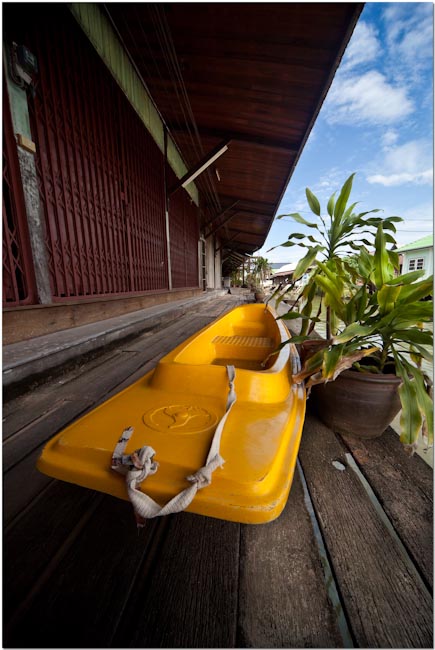
The resulting image is very nice indeed! The bright yellow contrasts nicely with the perfectly exposed sky and the green plants. The interesting texture of the deck boards adds interest.
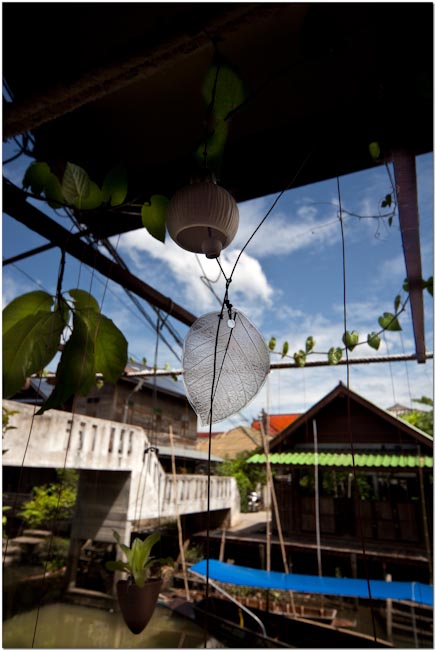
And then Luke goes and does it again. He makes an excellent capture and I didn’t even see him do it! I must have been daydreaming. This one is different, a great angle, contrasting blues and greens, and the capture makes you want to examine it
longer and figure out what exactly is in the scene.
It was a really hot day and it was right about now that we came upon the hotel café and grabbed a table to take in some water and chat a bit. I was still rattling on about how if you look around you can make an interesting capture out of the most
ordinary things we walk by and never notice. I continue in this direction until he notices me looking at a water fountain sculpture.
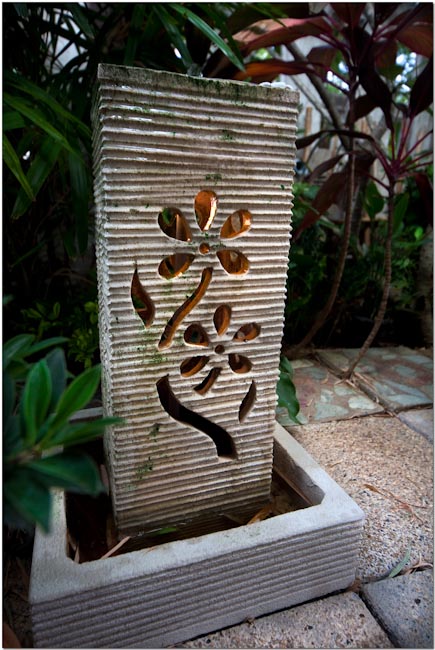
Looking at this fountain I noticed a warm light that looked like it was coming through from the other side. Not the best scene in the world, but the best the café had to offer. Luke makes the capture noting that the warm light source was in fact
a light bulb inside the fountain.
Finishing our drinks we head out for more and by now Luke has listened to me enough that he’s either very annoyed, or he’s looking for interesting photo opportunities just to shut me up. Not even 2-3 minutes later he makes an unusual effort
of climbing down a ladder to get closer to the water.
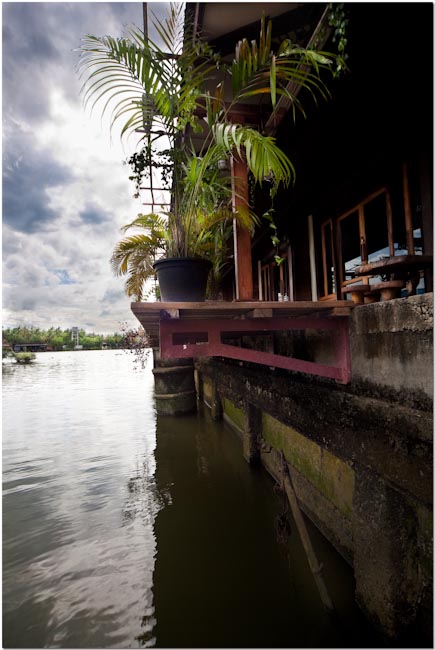
Immediately I can see what he’s doing. The perspective and contrasting light levels make for a very interesting if not easy capture. He brackets his exposures to ensure he gets an optimum sample. This image really gives you a feel for the place.
You can almost smell the water and felt the shade. Wonderful capture!
The Return to Bangkok
We pack up the gear and head back to Bangkok hoping to escape the Friday rush hour traffic and the threat of flooding the dark rain clouds hanging over the city promise. During the ride back we discussed more ultra-wide use and anything photographic that
came up. I’ve got to say, we also discussed a lot about ourselves. One of the great things about this job is meeting new and interesting people. Photographers seem to click.
We pull into my complex at about 1800, nine hours after we left. We bid farewell and thanks to my assistant and then head upstairs with all our gear.
Getting Comfortable
Workshop days can be long and exhausting. Luke had left his hotel at 0800 and 10 hours later we hadn’t even started the ‘second half’ of the workshop which is post processing. Often, we won’t finish up the day until 2300-2400
or until the student falls asleep on the computer which has happened more than once.
Processing should be slow and relaxed. You should be able to concentrate and retain. For these reasons I make available a guest room and shower and advise my students/clients to bring an extra set of clothes. After a full sweaty day it feels really good
to get clean. Some students/clients even take a nap for a few hours before continuing. Whatever it takes to be comfortable and ready to learn.
Usually I’ll order a pizza to munch before starting, but on this occasion my wife was home and she grilled some steaks and made a nice salad so we had a nice dinner indeed!
Computer Time
By now it’s about 1900 and we’re just getting started on the processing. As a matter of course I’ll ask the client/student to bring their laptop so I can walk them through how to color profile their screen. If they need to install
processing software (Lightroom) I’ll help them do this as well. Once they have a good understanding on color profiling and their computer is properly set up, I’ll suggest they pack it away.
We do all processing training on an ideally set up workstation with two monitors. Most people these days only own laptops and don’t have access to a desktop, so this workstation is a high end graphics workstation laptop. Lots of power, and I know
it works as it should so we won’t need to waste time troubleshooting a clients computer.
An external professional graphics monitor (21.5”) is connected as a second monitor. Also, a high end mouse, card reader, and graphics tablet. We uploaded Luke’s images and settled in to going over the basics of post processing.
I recommend and teach Lightroom. I can also include Adobe Photoshop CS3 or CS4, Photomatix HDR software, Capture One Pro 4, Bibble, and many other software packages if you choose to use these.
This is the part I love. Most people are intimidated by computers, or at least expect a steep learning curve. Adobe Lightroom is a difficult program to learn on your own, but a very easy program to become proficient on with just a bit of instruction.
The user interface UI is also designed so it can be used at a basic level, or an advanced level. And levels in between.
Within 90 minutes we’ve gone over the essential features and use of Adobe Lightroom 2.4 and Luke is amazed how easy this looks, and more amazed with the advantages of RAW files and the editing changes possible. He can’t wait to work a bit
on his own. I suggest he work for an hour uninterrupted, fight his way through any questions (this helps reinforcement), save up his questions, and then we’ll work together to answer those questions.
An hour goes by and I keep glancing over to see if he’s experiencing frustration, but all I see is a big smile. He’s having a ball. When the software is easy to use and allows you a great amount of control then post processing becomes fun
and enjoyable.
The Day Ends
After, we clear up any remaining questions and he says he’s had enough for the say. It’s about 2300 and I can understand him getting tired. After packing his gear my wife takes him downstairs to the ever present taxi queue and makes sure
the taxi driver knows what hotel he needs to take him to.
Overall a great day! About 14-15 hours, two meals, and lots and lots of camera stuff. What more fun could I ask for?
Thank you Luke, both for the use of your images and the use of your experiences.
A One Year Anniversary Blog Entry
Fresh Material
When I first started writing this column my main fear was that I’d run out of things to write about. How in the world could I come up with fresh outing material and fresh learning topics week after week?
I must admit if I allow myself to think about it the fear is still there. How Stick has made his column as interesting and fresh year after year is beyond my comprehension. But I’m starting to understand.
When you really love what you’re doing, when you look forward to each workshop, each shoot, and then sharing the experiences with a growing readership.. then time flies by and before you know it a year has gone by!
Again, thank you to everyone for your contributions and support.
Until next time…



